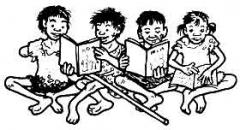Your progress
0%
The activities below can help you address the needs of people with disabilities in accessing non-formal education opportunities

Use your mouse or keyboard to expand each of the activity headings below. To add an activity to your action plan, select the Add button beside it. Once you have added an activity to your action plan, select Action plan > My action plan from the menu above to complete that activity.
A wide range of non-formal education programmes may already be operating in the community. These programmes may be oriented towards many types of subjects, such as literacy and basic education health promotion, including reproductive health issues, sexually transmitted diseases and HIV/AIDS, environmental issues, agriculture and workforce preparation.
Non-formal education programmes offer excellent opportunities for people with disabilities to be educated alongside their non-disabled peers. CBR can take a variety of actions to help support programmes in both the government and the community-based sectors.
Learn about how the Policy on Non-Formal Education in Nepal supports inclusive education at a government level.


Dung (pronounced Zoong) is a bright young man from a village outside Ho Chi Minh City, Vietnam. He is deaf and from an early age learned sign language and also learned how to read and write English. At the age of 25, he was working full-time and had a good life. Members from the Ho Chi Minh City Deaf Club and the leaders of a CBR project asked Dung to teach them English to open to them a world of literature and an alternative to writing phonetic Vietnamese. With the help of the CBR project, a local charity and the municipal government, 30 deaf young adults enrolled in the evening classes twice a week. Dung followed a regular English-as-a-second-language curriculum and materials. Each of the 20 regularly attending participants paid Dung the equivalent of about US$1 per lesson. They mastered basic English over the next two years, and then began working to develop and record their native sign language.
Non-formal educational programmes and curricula often have more flexibility than those of formal schools, which have to adhere to more rigid constraints. Because of this, non-formal education curricula can be more easily adapted to suit the needs of individuals, tailoring content and teaching methods so the material is relevant, appealing, feasible and meaningful to the particular group of students.
CBR can help ensure that non-formal education curricula are practical and relevant in many ways.
Learn about a CBR in Bangladesh that worked to provide older children a second chance at accessing education.


One non-formal education programme in Bangladesh works in urban communities in large cities such as Dhaka, Chittagong and Rajshahi. The programme especially focuses on children working in the informal sector (often hazardous work) or living and working on the streets, and includes children with different impairments. These children are older than their peers who attend non-formal education, and sometimes even too old to be enrolled. The programme consists of a condensed Non-formal education programme taught in half the time normally required in the formal system and which is more relevant to the older age-group – it is second-chance education for most of the students. Boys and girls of 10 years and older are invited to the programme. The classes are in three daily shifts to keep classes small and to allow children to continue to work and contribute to their family’s income. After the non-formal education programme, children can choose either to:
The non-formal education programme also has job placement officers who help students – with and without disabilities – to find employment after graduating from the programme.
Home-based learning can be supplementary, preparatory or an alternative to formal education. It can be relevant for students with extensive needs, for whom the priority is to learn basic daily living skills, basic communication and basic functioning. These skills are best learned in environments where they will be used rather than in artificial environments. CBR personnel can work closely with family members, teachers and students, carry out home visits on a regular basis and work with the entire family to ensure successful home-based learning.
Home-based learning, as part of a comprehensive strategy, is effective. However, when it operates in isolation, home-based learning can contribute to exclusion and isolation of children with disabilities, despite working closely with family members and sometimes with teachers. Because of this, it is important to assess carefully the situation for each family that practises home-based learning in your community to ensure that students who can benefit from inclusive learning environments outside the home have access to them.
Sometimes there is a specific learning need, such as learning sign language or Braille, that requires students to come together in their own groups to study. CBR personnel can provide assistance in developing and sustaining these groups, and can link students with disabilities with disabled people’s organizations, which can be a useful resource to facilitate their learning.
Learn about how a young man with a hearing impairment led a learning group in his community.


Dung (pronounced Zoong) is a bright young man from a village outside Ho Chi Minh City, Vietnam. He is deaf and from an early age learned sign language and also learned how to read and write English. At the age of 25, he was working full-time and had a good life. Members from the Ho Chi Minh City Deaf Club and the leaders of a CBR project asked Dung to teach them English to open to them a world of literature and an alternative to writing phonetic Vietnamese. With the help of the CBR project, a local charity and the municipal government, 30 deaf young adults enrolled in the evening classes twice a week. Dung followed a regular English-as-a-second-language curriculum and materials. Each of the 20 regularly attending participants paid Dung the equivalent of about US$1 per lesson. They mastered basic English over the next two years, and then began working to develop and record their native sign language.
Non-formal education may not be valued the same way as formal education. Non-formal education programmes tend to use different and more flexible curricula and teaching methods. These may benefit learners, but can also jeopardize a student’s transition into the formal system. Without systematic links between the formal and non-formal education systems, non-formal education may contribute to the segregation of people with disabilities.
Learn about how the Indian government worked to incorporate home-based education with formal education programmes.


The Indian government recognizes home-based education for children with disabilities as an official alternative form of education for those who have difficulty accessing schools or who are left out of the education system for some reason. The government programme provides counselling support for parents and raises awareness about the importance of sending children to school. The education department is responsible for identifying volunteers from the local community with help and coordination of local non-governmental organizations. Each volunteer works with three children, and is paid an honorarium by the school authorities. Once brought into home-based education, the child is enrolled in the neighbourhood school, and the school authorities become responsible for him/her. Through this scheme, the government is able to reach those who can’t reach school, and work with the child at home until he or she is ready for inclusion or is provided with skills for life. This initiative creates an effective link between non-formal and formal education programmes, facilitates inclusion, and provides new opportunities for learning.